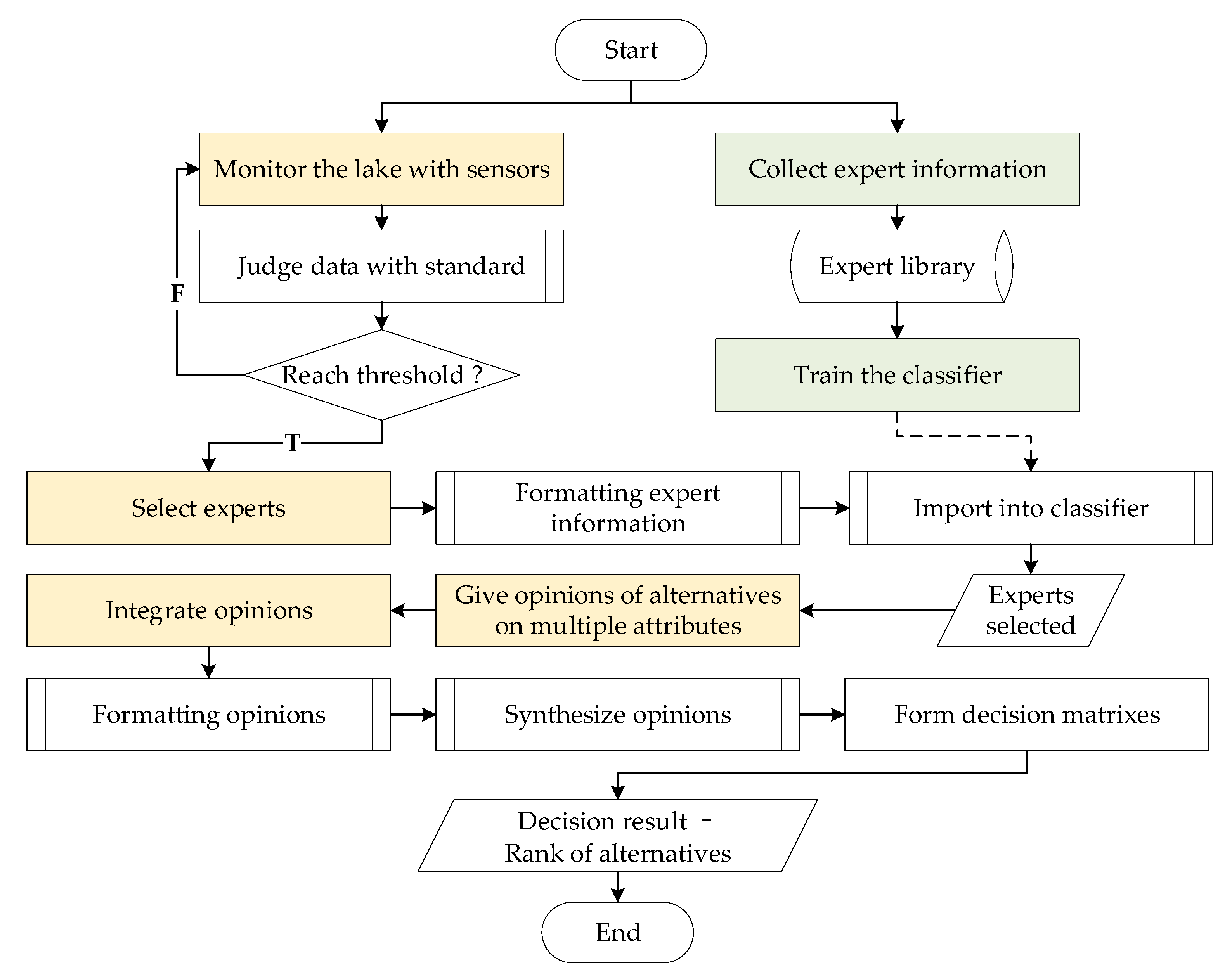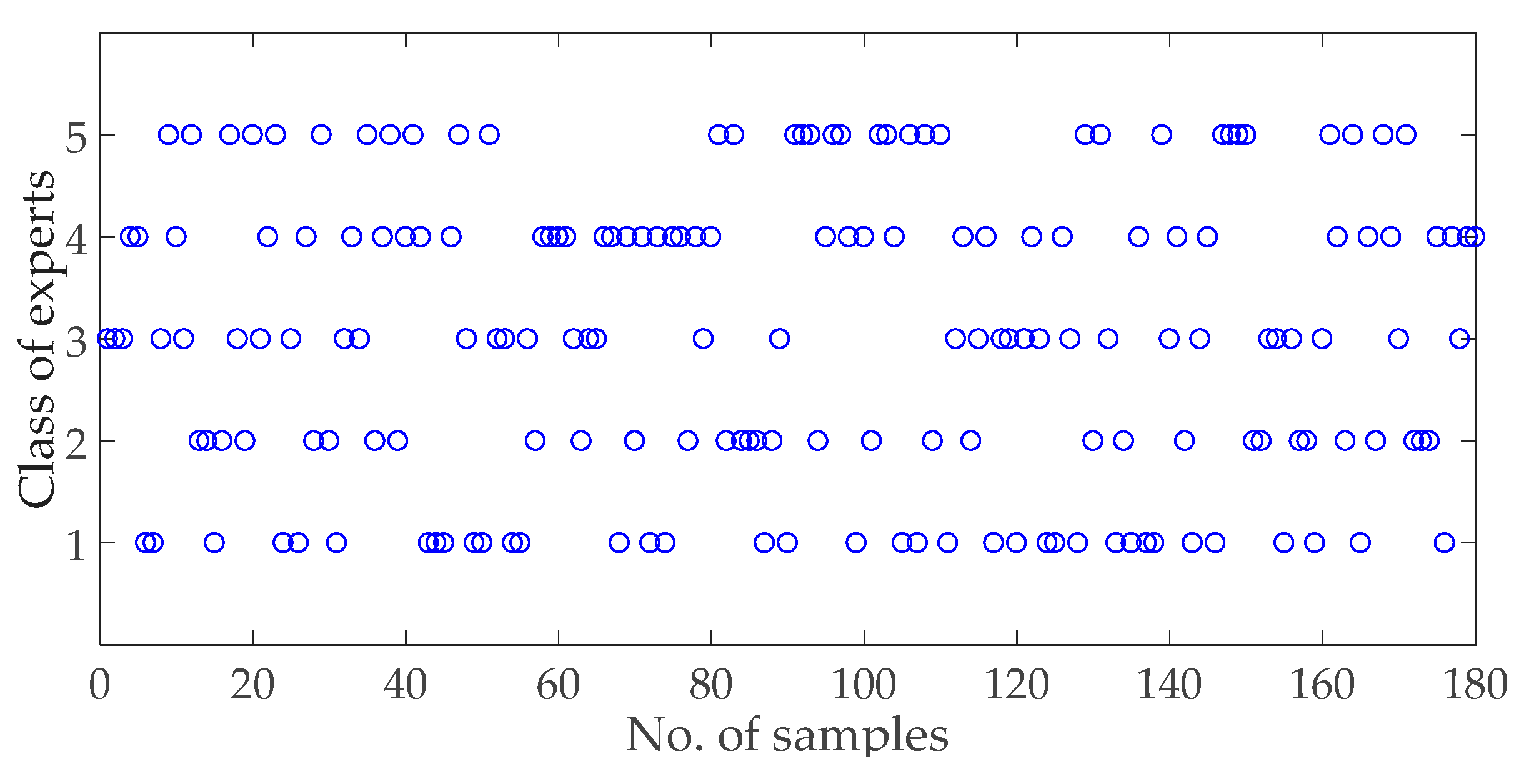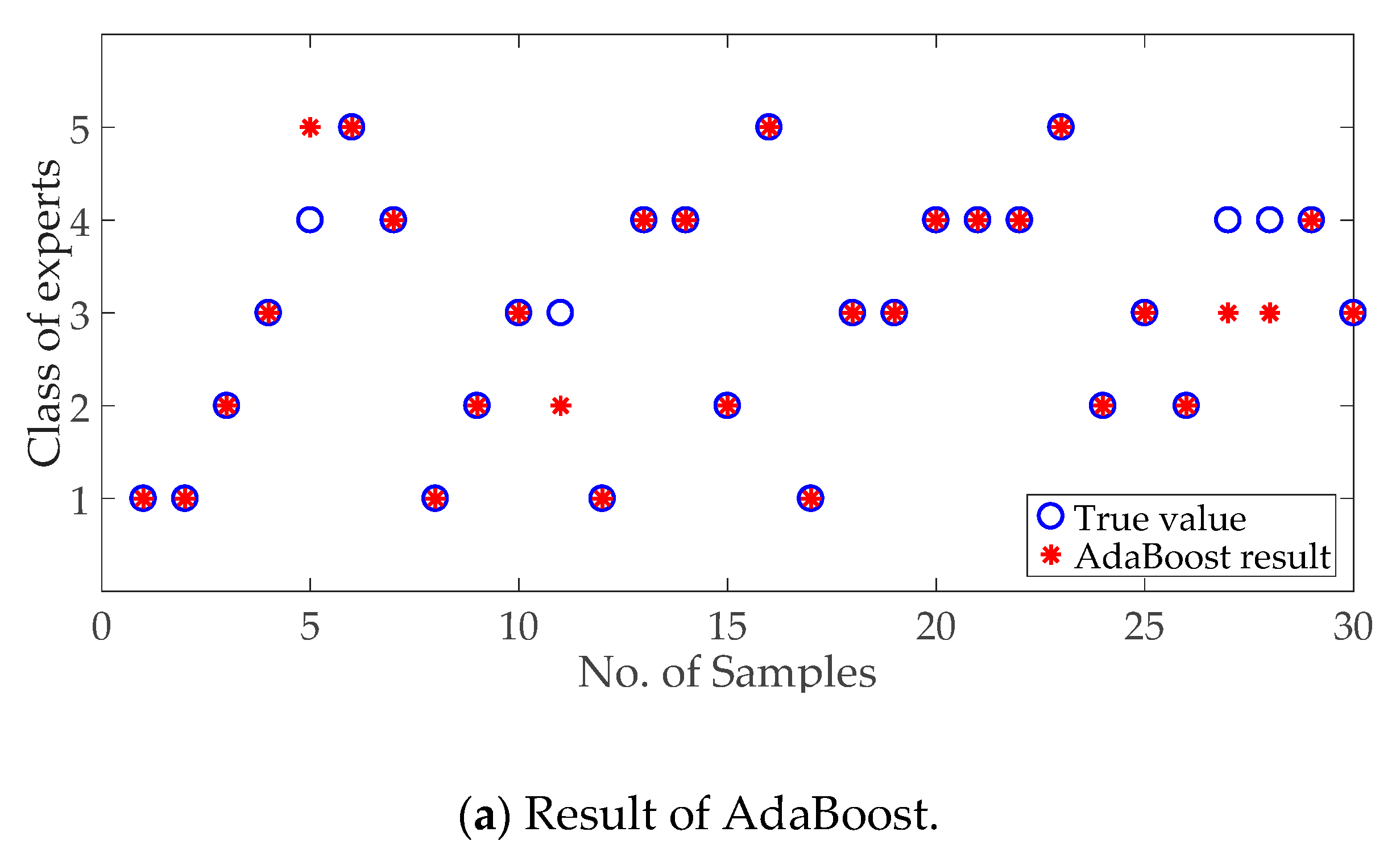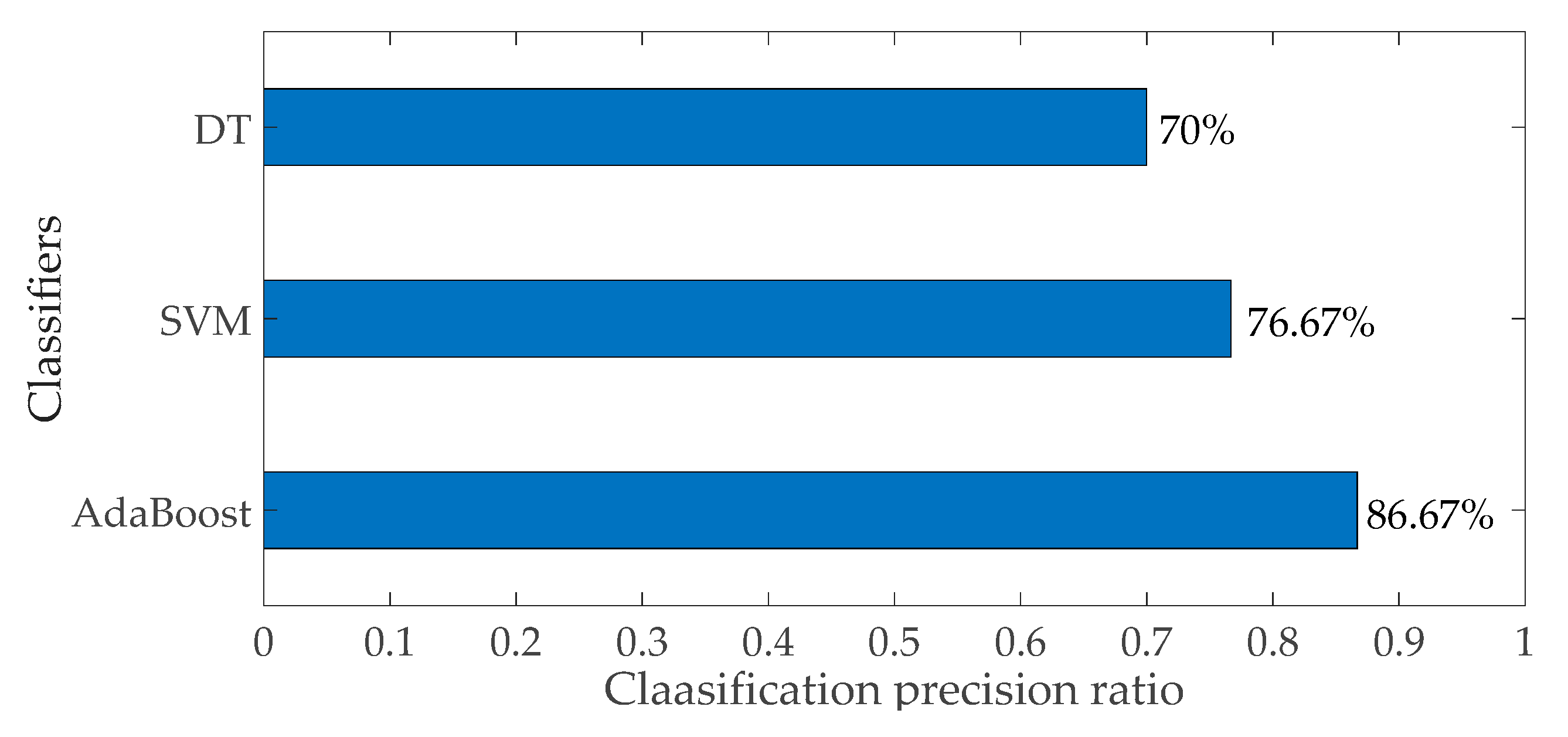Group Decision-Making Support for Sustainable Governance of Algal Bloom in Urban Lakes
Abstract
1. Introduction
2. Related Works
2.1. Algal Bloom Governance and Sustainable Management
2.2. The Decision Support Technique
3. Materials and Methods
3.1. Problem Description
3.2. Study Area and Experimental Data
3.3. Group Decision-Making Method
3.3.1. Group Decision-Making Framework
3.3.2. Method of Expert Selection and Weight Definition
| Algorithm 1: Classifier training for expert selection |
| Input: structured expert information (shown in Table 2), 9 variables of each expert form a sample set . , and is the category label of the expert. is corresponding to the sample set , and the values of 1-5 represent the descending professional grades. Output: classifier used to classify and select experts. Procedure % Initialize the weights of samples for i = 1; i ≤ N; i++ ; % is the initialized sample weight end for % Train weak classifiers iteratively for m = 1; m ≤ M; m++ for i=1; i<=N; i++ end for end for % Obtain the final classifier % sign is the activation function. End Procedure |
3.3.3. Method of Decision Opinion Integration
4. Results
4.1. Expert Selection
4.2. Opinion Integration
5. Discussion
5.1. Comparison of Expert Classification
5.2. Comparison of Decision-Making Results
5.3. Extension and Improvement of Group Decision-Making
6. Conclusions
Author Contributions
Funding
Conflicts of Interest
References
- Bulletin on Beijing’s Ecological Environment State in 2018. Available online: http://sthjj.beijing.gov.cn/bjhrb/zrqskqzl/849908 (accessed on 9 May 2018). (In Chinese)
- Visser, P.M.; Ibelings, B.W.; Bormans, M.; Huisman, J. Artificial mixing to control cyanobacterial blooms: A review. Aquat. Ecol. 2016, 50, 423–441. [Google Scholar] [CrossRef]
- Sun, R.; Sun, P.; Zhang, J.; Esquivel-Elizondo, S.; Wu, Y. Microorganisms-based methods for harmful algal blooms control: A review. Bioresour. Technol. 2018, 248, 12–20. [Google Scholar] [CrossRef] [PubMed]
- Bose, R.; Sugumaran, V. Semantic web technologies for enhancing intelligent DSS environments. In Decision Support for Global Enterprises; Springer: Boston, MA, USA, 2007; pp. 221–238. [Google Scholar]
- Morente-Molinera, J.A.; Wikström, R.; Herrera-Viedma, E.; Carlsson, C. A linguistic mobile decision support system based on fuzzy ontology to facilitate knowledge mobilization. Decis. Support Syst. 2016, 81, 66–75. [Google Scholar] [CrossRef]
- Bozanic, D.; Tešić, D.; Milićević, J. A hybrid fuzzy AHP-MABAC model: Application in the Serbian Army–The selection of the location for deep wading as a technique of crossing the river by tanks. Decis. Mak. Appl. Manag. Eng. 2018, 1, 143–164. [Google Scholar] [CrossRef]
- Wang, X.; Chen, C.; Liu, Z.; Xu, J.; Hao, Q.; Liu, P. Research on the Emergency Control Decision on Water Bloom in Lake and Reservoir Based on Fuzzy Bayes under Comprehensive Restrictions. In Proceedings of the Second International Conference on IEEE, Sanya, Hainan, China, 6–7 January 2012; pp. 894–898. [Google Scholar]
- Liu, Z.; Li, L.; Wang, X.; Chen, C. Researches of water bloom emergency management decision-making method and system based on fuzzy multiple attribute decision making. Int. J. Comput. Sci. Issues 2012, 9, 48–53. [Google Scholar]
- Bai, Y.; Wang, X.; Wang, L.; Xu, J.; Yu, J.; Shi, Y. The research of decision-making method for multi-objective in water bloom emergency governance based on Vague set theory. J. Comput. Inf. Syst. 2014, 10, 2099–2106. [Google Scholar]
- Bai, Y.-T.; Zhang, B.-H.; Wang, X.-Y.; Jin, X.-B.; Xu, J.-P.; Su, T.-L.; Wang, Z.-Y. A novel group decision-making method based on sensor data and fuzzy information. Sensors 2016, 16, 1799. [Google Scholar] [CrossRef]
- Bai, Y.-T.; Zhang, B.-H.; Wang, X.-Y.; Jin, X.-B.; Xu, J.-P.; Wang, Z.-Y. Expert decision support technique for algal bloom governance in urban lakes based on text analysis. Water 2017, 9, 308. [Google Scholar] [CrossRef]
- Bai, Y.-t.; Jin, X.-b.; Wang, X.-y.; Wang, X.-k.; Xu, J.-p. Dynamic correlation analysis method of air pollutants in spatio-temporal analysis. Int. J. Environ. Res. Public Health 2020, 17, 360. [Google Scholar] [CrossRef]
- Fazlollahtabar, H.; Smailbašić, A.; Stević, Ž. FUCOM method in group decision-making: Selection of forklift in a warehouse. Decis. Mak. Appl. Manag. Eng. 2019, 2, 49–65. [Google Scholar] [CrossRef]
- Sekulić, V.; Pavlović, M. Corporate social responsibility in relations with social community: Determinants, development, management aspects. Ekonomika 2018, 64, 59–69. [Google Scholar] [CrossRef]
- Radukić, S.; Petrović-Ranđelović, M.; Kostić, Z. Sustainability-based goals and achieved results in Western Balkan countries. Econ. Sustain. Dev. 2019, 3, 9–18. [Google Scholar] [CrossRef]
- Jin, X.; Yang, N.; Wang, X.; Bai, Y.; Su, T.; Kong, J. Deep hybrid model based on EMD with classification by frequency characteristics for long-term air quality prediction. Mathematics 2020, 8, 214. [Google Scholar] [CrossRef]
- Wang, L.; Zhang, T.; Wang, X.; Jin, X.; Xu, J.; Yu, J.; Zhang, H.; Zhao, Z. An approach of improved multivariate timing-random deep belief net modelling for algal bloom prediction. Biosyst. Eng. 2019, 177, 130–138. [Google Scholar] [CrossRef]
- Zheng, Y.; Kong, J.; Jin, X.; Wang, X.; Su, T.; Zuo, M. Cropdeep: The crop vision dataset for deep-learning-based classification and detection in precision agriculture. Sensors 2019, 19, 1058. [Google Scholar] [CrossRef] [PubMed]
- Cui, T.; Ding, F.; Jin, X.; Alsaedi, A.; Hayat, T. Joint multi-innovation recursive extended least squares parameter and state estimation for a class of state-space systems. Int. J. Control Autom. Syst. 2020, 17, 1–13. [Google Scholar] [CrossRef]
- Ding, F.; Xu, L.; Meng, D.; Jin, X.; Alsaedi, A.; Hayat, T. Gradient estimation algorithms for the parameter identification of bilinear systems using the auxiliary model. J. Comput. Appl. Math. 2020, 369. [Google Scholar] [CrossRef]
- Wang, F.; Su, T.; Jin, X.; Zheng, Y.; Kong, J.; Bai, Y. Indoor Tracking by RFID Fusion with IMU Data. Asian J. Control 2019, 21. [Google Scholar] [CrossRef]
- Wang, Z.; Jin, X.; Wang, X.; Xu, J.; Bai, Y. Hard decision-based cooperative localization for wireless sensor networks. Sensors 2019, 19, 4665. [Google Scholar] [CrossRef]
- Bai, Y.; Wang, X.; Jin, X.; Su, T.; Kong, J. Adaptive filtering for MEMS gyroscope with dynamic noise model. ISA Trans. 2020. [Google Scholar] [CrossRef]
- Zhao, Z.; Yao, P.; Wang, X.; Xu, J.; Wang, L.; Yu, J. Reliable flight performance assessment of multirotor based on interacting multiple model particle filter and health degree. Chin. J. Aeronaut. 2019, 32, 444–453. [Google Scholar] [CrossRef]
- Wang, X.; Zhou, Y.; Zhao, Z.; Wei, W.; Li, W. Time-delay system control based on an integration of active disturbance rejection and modified twice optimal control. IEEE Access 2019, 7, 130734–130744. [Google Scholar] [CrossRef]
- Pamučar, D.; Božanić, D. Selection of a location for the development of multimodal logistics center: Application of single-valued neutrosophic MABAC model. Oper. Res. Eng. Sci. Theory Appl. 2019, 2, 55–71. [Google Scholar] [CrossRef]
- Hassanpour, M.; Pamucar, D. Evaluation of Iranian household appliance industries using MCDM models. Oper. Res. Eng. Sci. Theory Appl. 2019, 2, 1–25. [Google Scholar] [CrossRef]
- Naeini, A.B.; Mosayebi, A.; Mohajerani, N. A hybrid model of competitive advantage based on Bourdieu capital theory and competitive intelligence using fuzzy Delphi and ism-gray Dematel (study of Iranian food industry). Int. Rev. 2019, 1–2, 21–35. [Google Scholar] [CrossRef]
- Karabašević, D.; Popović, G.; Stanujkić, D.; Maksimović, M.; Sava, C. An approach for hotel type selection based on the single-valued intuitionistic fuzzy numbers. Int. Rev. 2019, 1–2, 7–14. [Google Scholar] [CrossRef]
- Spoladore, D.; Sacco, M. Semantic and dweller-based decision support system for the reconfiguration of domestic environments: RecAAL. Electronics 2018, 7, 179. [Google Scholar] [CrossRef]
- Liu, B.; Cui, L.; Liu, Z. Correlation between chlorophyll a and algal density of surface water in urban of Beijing. Environ. Sci. Technol. 2008, 31, 29–33. (In Chinese) [Google Scholar]
- Wang, X.; Zhou, Y.; Zhao, Z.; Wang, L.; Xu, J.; Yu, J. A novel water quality mechanism modeling and eutrophication risk assessment method of lakes and reservoirs. Nonlinear Dyn. 2019, 96, 1037–1053. [Google Scholar] [CrossRef]
- Collins, M.; Schapire, R.E.; Singer, Y. Logistic regression, AdaBoost and Bregman distances. Mach. Learn. 2002, 48, 253–285. [Google Scholar] [CrossRef]
- Kim, K.; Lin, H.; Jin, Y.C.; Choi, K. A design framework for hierarchical ensemble of multiple feature extractors and multiple classifiers. Pattern Recogn. C 2016, 52, 1–16. [Google Scholar] [CrossRef]
- Wei, G. Some harmonic aggregation operators with 2-tuple linguistic assessment information and their application to multiple attribute group decision making. Int. J. Uncertain. Fuzziness Knowl. Based Syst. 2011, 19, 977–998. [Google Scholar] [CrossRef]
- Bonate, P.L. A brief introduction to Monte Carlo simulation. Clin. Pharmacokinet. 2001, 40, 15–22. [Google Scholar] [CrossRef] [PubMed]
- Guenther, N.; Schonlau, M. Support vector machines. Stata J. 2016, 16, 917–937. [Google Scholar] [CrossRef]
- Song, Y.Y.; Ying, L.U. Decision tree methods: Applications for classification and prediction. Shanghai Arch. Psychiatry 2015, 27, 130. [Google Scholar]
- Wang, L.; Zhang, T.; Jin, X.; Xu, J.; Wang, X.; Zhang, H.; Yu, J.; Sun, Q.; Zhao, Z.; Xie, Y. An approach of recursive timing deep belief network for algal bloom forecasting. Neural Comput. Appl. 2020, 32, 163–171. [Google Scholar] [CrossRef]
- Jin, X.; Yang, N.; Wang, X.; Bai, Y.; Su, T.; Kong, J. Integrated predictor based on decomposition mechanism for PM2.5 long-term prediction. Appl. Sci. 2019, 9, 4533. [Google Scholar] [CrossRef]
- Bai, Y.; Jin, X.; Wang, X.; Su, T.; Kong, J.; Lu, Y. Compound autoregressive network for prediction of multivariate time series. Complexity 2019, 9107167. [Google Scholar] [CrossRef]
- Bai, Y.; Wang, X.; Sun, Q.; Jin, X.; Wang, X.; Su, T.; Kong, J. Spatio-temporal prediction for the monitoring-blind area of industrial atmosphere based on the fusion network. Int. J. Environ. Res. Public Health 2019, 16, 3788. [Google Scholar] [CrossRef]
- Jin, X.; Yu, X.; Wang, X.; Bai, Y.; Su, T.; Kong, J. Deep Learning Predictor for Sustainable Precision Agriculture Based on Internet of Things System. Sustainability 2020, 12, 1433. [Google Scholar]
- Ding, F.; Lv, L.; Pan, J.; Wan, X.; Jin, X. Two-stage gradient-based iterative estimation methods for controlled autoregressive systems using the measurement data. Int. J. Control Autom. Syst. 2019, 17. [Google Scholar] [CrossRef]
- Bai, Y.-t.; Wang, X.-y.; Jin, X.-b.; Zhao, Z.-y.; Zhang, B.-h. A neuron-based Kalman filter with nonlinear autoregressive model. Sensors 2020, 20, 299. [Google Scholar] [CrossRef] [PubMed]









| Time | Temperature (℃) | DO (mg/L) | TP (mg/L) | TN (mg/L) | Chl_a (μg/L) | Illumination (lx) | pH | Flow rate (m3/s) | Wind Speed (m/s) |
|---|---|---|---|---|---|---|---|---|---|
| 5:00 | 20.28 | 7.21 | 0.021 | 2.09 | 28.5 | 3.01 | 7.09 | 0.12 | 3.2 |
| 6:00 | 20.32 | 7.84 | 0.021 | 2.05 | 27.4 | 8.39 | 7.09 | 0.11 | 3.1 |
| 7:00 | 20.6 | 8.35 | 0.021 | 0.96 | 29.6 | 15.35 | 7.05 | 0.12 | 3.3 |
| 8:00 | 21.11 | 8.65 | 0.021 | 1.41 | 30.3 | 21.29 | 7.09 | 0.14 | 3.8 |
| 9:00 | 21.83 | 8.95 | 0.021 | 1.28 | 32.6 | 25.5 | 7.04 | 0.11 | 3.2 |
| 10:00 | 21.73 | 9.16 | 0.021 | 1.09 | 30.6 | 28.51 | 7.09 | 0.1 | 2.9 |
| 11:00 | 22.78 | 9.52 | 0.022 | 1 | 32.5 | 32.9 | 7.09 | 0.15 | 3.1 |
| 12:00 | 23.96 | 9.82 | 0.023 | 1.91 | 35.8 | 34.28 | 7.09 | 0.09 | 2.8 |
| 13:00 | 25.18 | 10.09 | 0.024 | 2.13 | 37.5 | 33.54 | 7.09 | 0.09 | 2.9 |
| 14:00 | 24.16 | 10.05 | 0.025 | 2.56 | 38.2 | 24.21 | 7.05 | 0.11 | 2.8 |
| Expert | f1 | f2 | f3 | f4 | f5 | f6 | f7 | f8 | f9 |
|---|---|---|---|---|---|---|---|---|---|
| Exp1 | 1 | 57 | 1 | 1 | 28 | 22 | 6 | 20 | 16 |
| Exp2 | 1 | 43 | 1 | 1 | 17 | 21 | 7 | 9 | 13 |
| Exp3 | 2 | 36 | 1 | 2 | 10 | 9 | 3 | 3 | 2 |
| ... ... | ... ... | ... ... | ... ... | ... ... | ... ... | ... ... | ... ... | ... ... | ... ... |
| Exp56 | 4 | 23 | 2 | 1 | 3 | 1 | 0 | 1 | 0 |
| Exp57 | 3 | 30 | 1 | 2 | 8 | 12 | 4 | 3 | 6 |
| No. | Expert Feature Factors | Optional Values |
|---|---|---|
| f1 | professional title | 1: professor/researcher; 2: associate professor/researcher; 3: middle; 4: other |
| f2 | age | real number |
| f3 | highest education degree | 1: doctor; 2: master; 3: bachelor; 4: other |
| f4 | major of environment | 1 true; 2 false |
| f5 | number of papers in CNKI | real number |
| f6 | number of papers in WOS | real number |
| f7 | number of patents | real number |
| f8 | number of papers about algal bloom | real number |
| f9 | number of patents about algal bloom | real number |
| Class 1 | Class 2 | Class 3 | Class 4 | Class 5 |
|---|---|---|---|---|
| Exp1, Exp2, Exp8, Exp12, Exp17 | Exp3, Exp9, Exp11, Exp15, Exp24, Exp26 | Exp4, Exp10, Exp18, Exp19, Exp25, Exp27, Exp28, Exp 30 | Exp7, Exp13, Exp14, Exp20, Exp21, Exp29, Exp22, | Exp5, Exp6, Exp16, Exp23 |
| b1 | b2 | b3 | b4 | b5 | ||
|---|---|---|---|---|---|---|
| Exp 1 | a1 | (RH,0.88) | (VH,0.24) | (RH,0.48) | (AH,0.04) | (AH,0.31) |
| a2 | (AH,0.21) | (AH,0.41) | (VH,0.69) | (AH,0.56) | (AH,0.96) | |
| a3 | (AH,0.97) | (AH,0.77) | (VH,0.96) | (AL,0.77) | (AL,0.42) | |
| a4 | (RL,0.64) | (RL,0.09) | (L,0.73) | (M,0.71) | (VL,0.67) | |
| a5 | (VL,0) | (L,0.88) | (RH,0.84) | (VH,0.39) | (H,0.34) | |
| a6 | (VH,0.56) | (AL,0.05) | (VL,0.29) | (VH,0.18) | (VH,0.48) | |
| a7 | (AH,0.42) | (AL,0.65) | (AL,0.91) | (AH,0.63) | (VH,0.84) | |
| Exp 2 | a1 | (H,0.96) | (AH,0.49) | (M,0.14) | (VH,0.32) | (AH,0.46) |
| a2 | (VH,0.62) | (AH,0.36) | (RH,0.23) | (VH,0.31) | (VH,0.67) | |
| a3 | (VH,0.14) | (VH,0.58) | (H,0.51) | (VL,0.65) | (VL,0.11) | |
| a4 | (M,0.25) | (M,0.27) | (RL,0.65) | (L,0.42) | (L,0.58) | |
| a5 | (L,0.66) | (RL,0.49) | (M,0.8) | (H,0.87) | (VH,0.75) | |
| a6 | (H,0.51) | (VL,0.19) | (L,0.35) | (H,0.93) | (H,0.22) | |
| a7 | (VH,0.04) | (VL,0.29) | (L,0.58) | (VH,0.36) | (VH,0.9) | |
| Exp 9 | a1 | (VH,0.1) | (VH,0.77) | (RL,0.4) | (AH,0.73) | (AH,0.85) |
| a2 | (RL,0.14) | (RL,0.92) | (VL,0.45) | (M,0.79) | (M,0.26) | |
| a3 | (L,0.11) | (L,0.32) | (M,0.57) | (M,0.69) | (M,0.5) | |
| a4 | (M,0.52) | (RL,0.75) | (RL,0.58) | (VL,0.22) | (AL,0.13) | |
| a5 | (VL,0.73) | (RL,0.46) | (L,0.57) | (H,0.91) | (VH,0.14) | |
| a6 | (VL,0.31) | (AL,0.09) | (VL,0.53) | (VL,0.74) | (RL,0.42) | |
| a7 | (L,0.68) | (AL,0.58) | (AL,0.1) | (M,0.83) | (M,0.59) | |
| Exp 15 | a1 | (M,0.81) | (RL,0.02) | (VL,0.82) | (VH,0.06) | (H,0.12) |
| a2 | (AH,0.63) | (AH,0.72) | (VH,0.28) | (VH,0.01) | (AH,0.86) | |
| a3 | (AH,0.54) | (VH,0.52) | (M,0.06) | (AL,0.21) | (AL,0.05) | |
| a4 | (VL,0.87) | (L,0.72) | (RL,0.36) | (RL,0.85) | (M,0.25) | |
| a5 | (AL,0.26) | (AL,0.22) | (M,0.99) | (RH,0.87) | (RH,0.63) | |
| a6 | (M,0.89) | (RL,0.15) | (VL,0.8) | (VH,0.16) | (AH,0.7) | |
| a7 | (M,0.79) | (RL,0.08) | (AL,0.69) | (VH,0.23) | (AH,0.13) |
| Class 1 | Class 2 | Class 3 | Class 4 | Class 5 | |
|---|---|---|---|---|---|
| Class 1 | 100% | 0 | 0 | 0 | 0 |
| Class 2 | 0 | 100% | 0 | 0 | 0 |
| Class 3 | 0 | 14.29% | 85.71% | 0 | 0 |
| Class 4 | 0 | 0 | 20% | 70% | 10% |
| Class 5 | 0 | 0 | 0 | 0 | 100% |
© 2020 by the authors. Licensee MDPI, Basel, Switzerland. This article is an open access article distributed under the terms and conditions of the Creative Commons Attribution (CC BY) license (http://creativecommons.org/licenses/by/4.0/).
Share and Cite
Yang, Y.; Bai, Y.; Wang, X.; Wang, L.; Jin, X.; Sun, Q. Group Decision-Making Support for Sustainable Governance of Algal Bloom in Urban Lakes. Sustainability 2020, 12, 1494. https://doi.org/10.3390/su12041494
Yang Y, Bai Y, Wang X, Wang L, Jin X, Sun Q. Group Decision-Making Support for Sustainable Governance of Algal Bloom in Urban Lakes. Sustainability. 2020; 12(4):1494. https://doi.org/10.3390/su12041494
Chicago/Turabian StyleYang, Yi, Yuting Bai, Xiaoyi Wang, Li Wang, Xuebo Jin, and Qian Sun. 2020. "Group Decision-Making Support for Sustainable Governance of Algal Bloom in Urban Lakes" Sustainability 12, no. 4: 1494. https://doi.org/10.3390/su12041494
APA StyleYang, Y., Bai, Y., Wang, X., Wang, L., Jin, X., & Sun, Q. (2020). Group Decision-Making Support for Sustainable Governance of Algal Bloom in Urban Lakes. Sustainability, 12(4), 1494. https://doi.org/10.3390/su12041494






